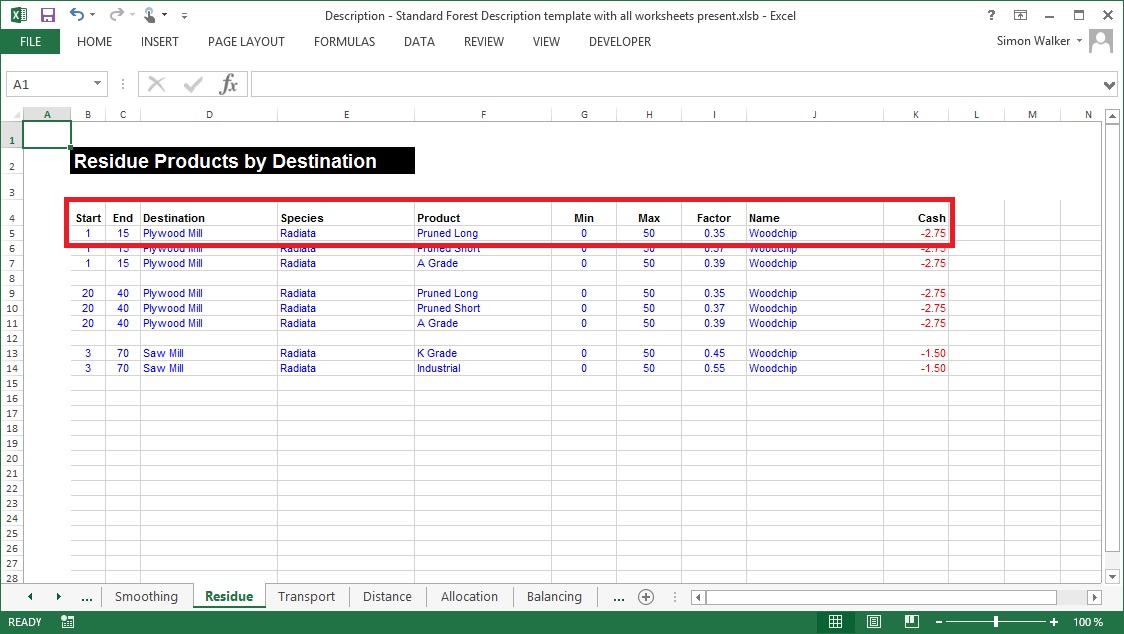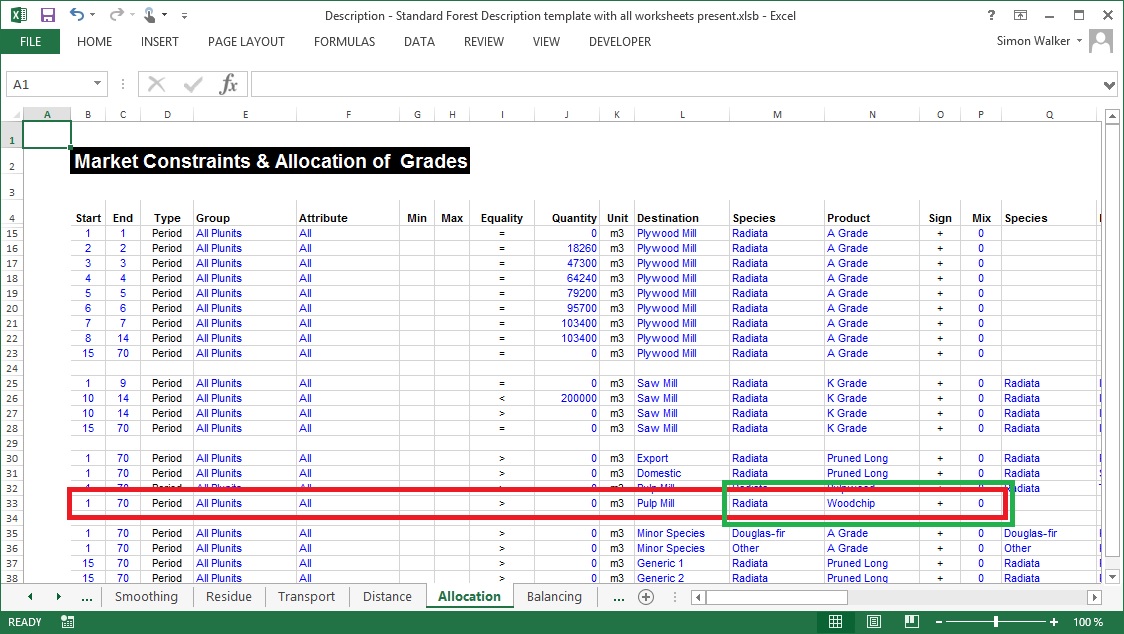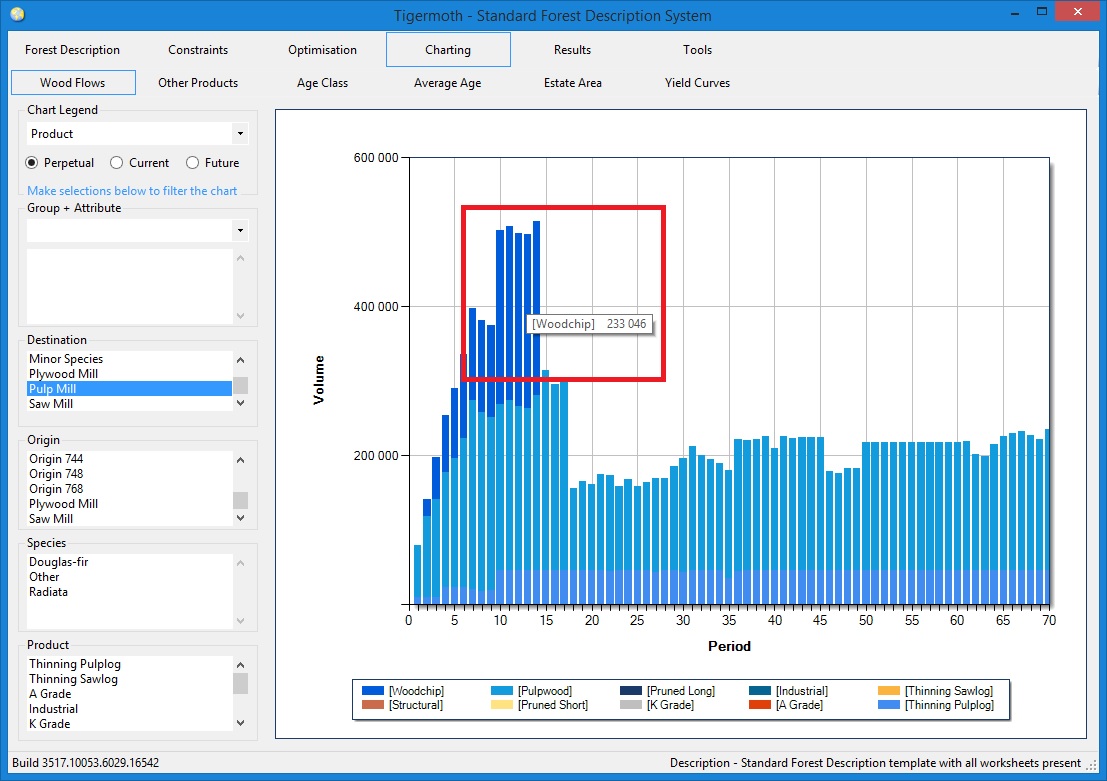Residue Worksheet¶
Optional Worksheet
Defines new log residue products that can be used in the allocation model to satisfy destination demands. Log residue products arise from the conversion of log grade products at a destination. This destination then becomes a supply origin with an associated transport cost.
It is possible to defined new products that can be used in the allocation model to satisfy destination specific wood demand requirements. These new products are called log residue products and arise from the conversion of the base log grade products defined in the forest description yield tables. Examples of typical log residue products would be wood chips and sawdust residues that can be used to satisfy part of the total wood demand at destinations such as a Pulp Mills, MDF Facilities or Bio-Energy plants.
Log residues arise from the conversion of the base log grade products allocated to a destination. The destination becomes a new origin for the supply of log residue products. A transport cost is assigned to represent the cost of delivering the log residue products from it's origin to the destinations where the log residue has been allocated. Cash costs of production and sales revenues for log residue products can also be defined.
Data always start at Cell 'B5'. The Columns 'B' to 'K' are mandatory, and must be kept in the same structure and location as the standard forest description template defines. Each row in the 'Residues' worksheet defines a time period across which a specific log residue product will be generated.

A description of the data types and requirements for worksheet 'Residues' is below:
[block:parameters] { "data": { "h-0": "-Column-", "0-0": "B & C", "0-1": "'Start' & 'End'", "h-1": "-Designation-", "1-0": "D", "1-1": "'Destination'", "2-0": "E", "2-1": "'Species'", "3-0": "F", "3-1": "'Product'", "4-0": "G & H", "5-0": "I", "4-1": "'Min' & 'Max'", "5-1": "'Factor'", "6-0": "J", "6-1": "'Name'", "7-0": "K", "7-1": "'Cash'", "0-2": "The starting and ending periods that form a range across which the log residue product defined in the same worksheet row can arise.", "1-2": "An existing destination within the forest estate model where the log grade product defined by Columns 'E' & 'F' is an allocated grade. This destination becomes a supply origin for the resulting log residue product.", "2-2": "The species of the log grade product that will be converted to a log residue product. The species/product combination must already be defined as a log grade that can be delivered to the destination stated in Column 'D'.", "3-2": "The log grade product that will be converted to a log residue product. The species/product combination must already be defined as a log grade that can be delivered to the destination stated in Column 'D'.", "4-2": "The minimum and maximum age of wood, between which the log grade product that can be converted to the log residue product. If the minimum and maximum age of wood is blank then any age is acceptable.", "5-2": "The factor used to convert the volume of log grade product to log residue product. For example, a factor of 0.36 means that for every 1 unit of log grade product delivered to the destination, then 0.36 units of the log residue product will arise.", "6-2": "The name of the log residue product being produced. This is subsequently used on both the 'Allocation' and the 'Price' worksheets when defining the allocation demand and selling price of the log residue product.", "7-2": "A Cost of Production (CPROD) cash flow item that is calculated and summarised in the modelling cash flows. This is applied on a converted basis, i.e. it is applied per unit of log residue product arising.", "h-2": "-Description Data-", "h-3": "" }, "cols": 3, "rows": 8 } [/block]
Note
It is important to understand the economic effect of modelling log residue products. Often the costs and revenues of these products are ignored, and only the volumes are considered. The supply of log residue products in place of green roundwood log volume makes a demand easier to achieve. However, the contribution margin of the log residue products needs to be carefully modelled and understood. The total green roundwood equivalent (RWE) volume generated by the forest estate should not be attributed more economic margin than it otherwise should. That is, when using log residue products make sure that the net economic effect is not a double counting of the contribution margin of the log grade products that are converted to the log residue products.
Define Transport Matrix¶
Once a log residue product has been defined on the 'Residues' worksheet the destination at which the conversion occurs itself becomes an origin from which the log residue product is supplied. Therefore all destinations at which a log residue product is created need to be added to the Transport and Distance worksheets as valid origins.
This is shown below, where in the example forest description data both the 'Plywood Mill' and the 'Saw Mill' destinations have been shown on the 'Residues' worksheet as destinations where log grade products are converted to log residue products. Therefore both the 'Plywood Mill' and the 'Saw Mill' destinations (shown in Green) are also allocation model origins and need a cost and distance defined for the destinations that use the log residue products in any allocation model demands.

Add Log Residue Demands¶
Log residue products can be used to satisfy the allocation model demands for wood supply at any Destination as long as a valid entry on the 'Transport' and 'Distance' worksheets have been defined. They are used in exactly the same way as standard log grade products that are supplied in the underlying yield tables in the forest description.
In the example below the log residue product 'Woodchip' has been allocated to the 'Pulp Mill' destination and can be used alongside any existing log grade products to satisfy the demand at this allocation model Destination.

Add Log Residue Pricing¶
Log residue products are given a selling price at the allocation model destinations in exactly the same way as log grade products. It is valid to make both the selling price and the transport cost equal to zero ($0) for on both the worksheets 'Price' and 'Transport'. A zero entry is valid and will allow the log residue product to be used in the relevant allocation model demands.

In the example below the wood supply to the 'Pulp Mill' destination is shown. The chart legend has been configured to show the modelling products, and the resulting chart shows the supply to the 'Pulp Mill' destination consists of both the 'Pulpwood' log grade product as well as 'Woodchip' log residue product. The allocation demand has therefore been achieved by using both green roundwood logs and green roundwood equivalent (RWE) woodchips.
